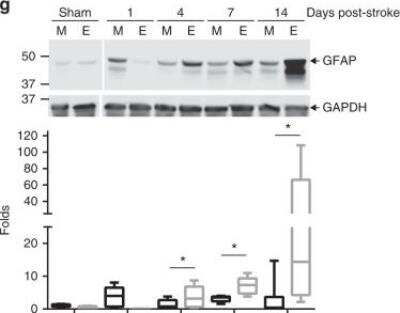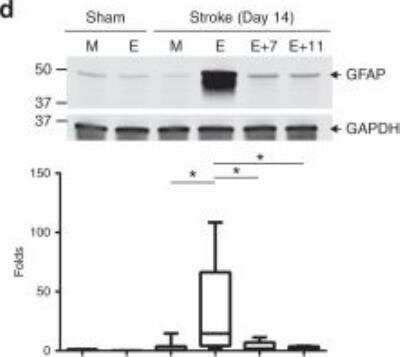GAPDH Antibody (6C5cc) [DyLight 680]
Novus Biologicals, part of Bio-Techne | Catalog # NB600-502FR


Conjugate
Catalog #
Forumulation
Catalog #
Key Product Details
Validated by
Biological Validation
Species Reactivity
Validated:
Human, Mouse, Rat, Porcine, Amphibian, Bovine (Negative), Canine, Chinese Hamster, Feline, Fish, Goat (Negative), Rabbit
Cited:
Human, Mouse
Applications
Validated:
ELISA, Immunoassay, Immunocytochemistry/ Immunofluorescence, Immunohistochemistry, Immunohistochemistry-Paraffin, Immunoprecipitation, Western Blot
Cited:
Western Blot
Label
DyLight 680 (Excitation = 692 nm, Emission = 712 nm)
Antibody Source
Monoclonal Mouse IgG1 Clone # 6C5cc
Concentration
Concentrations vary lot to lot. See vial label for concentration. If unlisted please contact technical services.
Product Specifications
Immunogen
Hybridoma clone has been derived from hybridization of Sp2/0 myeloma cells with spleen cells of Balb/c mice immunized with Rabbit GAPDH.
Reactivity Notes
Please note that this antibody is reactive to Mouse and derived from the same host, Mouse. Additional Mouse on Mouse blocking steps may be required for IHC and ICC experiments. Please contact Technical Support for more information. Chinese Hamster reactivity reported in scientific literature (PMID: 26115091).
Localization
Cytoplasmic, Nucleus, Membrane.
Clonality
Monoclonal
Host
Mouse
Isotype
IgG1
Theoretical MW
36 kDa.
Disclaimer note: The observed molecular weight of the protein may vary from the listed predicted molecular weight due to post translational modifications, post translation cleavages, relative charges, and other experimental factors.
Disclaimer note: The observed molecular weight of the protein may vary from the listed predicted molecular weight due to post translational modifications, post translation cleavages, relative charges, and other experimental factors.
Scientific Data Images for GAPDH Antibody (6C5cc) [DyLight 680]
GAPDH-Antibody-6C5cc-DyLight-680-Western-Blot-NB600-502FR-img0002.jpg
Western Blot: GAPDH Antibody (6C5cc) [DyLight 680] [NB600-502FR] -
Western Blot: GAPDH Antibody (6C5cc) [DyLight 680] [NB600-502FR] - Effective targeting of EcoHIV diminishes post-ischemic stroke inflammation. Mice were infected, treated with ART-7 & ART-11, & subjected to ischemic stroke as in Fig. 6b, c. mRNA levels of cellular activation markers Iba1 (a) & GFAP (b) 7 days post stroke. Protein expression levels of Iba1 (c), GFAP (d), & ICAM1 (e) were quantified by immunoblotting in sham & ischemic stroke animals at day 14 post-stroke in mock (M) & EcoHIV-infected (E) mice that were treated with ART-7 (E + 7) or ART-11 (E + 11). Representative blots are shown, & quantified results are illustrated on the bar graphs. mRNA levels of anti-inflammatory markers ICAM-5 (f) & FoxP3 (g), & tissue degrading enzymes MMP2 (h) & MMP9 (i) were quantified by RT-qPCR. Impact of therapy on viral DNA genome levels was evaluated in ipsilateral hemisphere (j) & spleen (k); n = 5–16 mice per group, 2 independent experiments. Whiskers-box plots represent centerline median, with interquartile range & min-max whiskers. Other graphs represent data as mean & SEM with individual data points. Source data are provided as a Source Data file. *p < 0.05 or **p < 0.01; one-way ANOVA, followed by Tukey multiple comparison test (a, b & f–k), & unpaired t test (c–e) Image collected & cropped by CiteAb from the following publication (https://pubmed.ncbi.nlm.nih.gov/31043599), licensed under a CC-BY license. Not internally tested by Novus Biologicals.Applications for GAPDH Antibody (6C5cc) [DyLight 680]
Application
Recommended Usage
ELISA
Optimal dilutions of this antibody should be experimentally determined.
Immunoassay
Optimal dilutions of this antibody should be experimentally determined.
Immunocytochemistry/ Immunofluorescence
Optimal dilutions of this antibody should be experimentally determined.
Immunohistochemistry
Optimal dilutions of this antibody should be experimentally determined.
Immunohistochemistry-Paraffin
Optimal dilutions of this antibody should be experimentally determined.
Immunoprecipitation
Optimal dilutions of this antibody should be experimentally determined.
Western Blot
Optimal dilutions of this antibody should be experimentally determined.
Formulation, Preparation, and Storage
Purification
Protein A purified
Formulation
50mM Sodium Borate
Preservative
0.05% Sodium Azide
Concentration
Concentrations vary lot to lot. See vial label for concentration. If unlisted please contact technical services.
Shipping
The product is shipped with polar packs. Upon receipt, store it immediately at the temperature recommended below.
Stability & Storage
Store at 4C in the dark.
Background: GAPDH
References
1) Barber RD, Harmer DW, Coleman RA, Clark BJ. (2005) GAPDH as a housekeeping gene: analysis of GAPDH mRNA expression in a panel of 72 human tissues. Physiol Genomics. 21(3):389-95. PMID: 15769908
2) Jia Y, Takimoto K. (2006) Mitogen-activated protein kinases control cardiac KChIP2 gene expression. Circ Res. 98(3):386-93. PMID: 16385079
3) Godsel LM, Hsieh SN, Amargo EV, Bass AE, Pascoe-McGillicuddy LT, Huen AC, Thorne ME, Gaudry CA, Park JK, Myung K, Goldman RD, Chew TL, Green KJ. (2005) Desmoplakin assembly dynamics in four dimensions: multiple phases differentially regulated by intermediate filaments and actin. J Cell Biol. 171(6):1045-59. PMID: 16365169
4) Sirover MA1. (1999) New insights into an old protein: the functional diversity of mammalian glyceraldehyde-3-phosphate dehydrogenase. Biochim Biophys Acta. 1432(2): 159-84. PMID: 10407139
5) Tristan C, Shahani N, Sedlak TW, Sawa A. (2011) The diverse functions of GAPDH: views from different subcellular compartments. Cell Signal. 23(2):317-23. PMID: 20727968
Long Name
Glyceraldehyde-3-phosphate Dehydrogenase
Alternate Names
G3PDH
Gene Symbol
GAPDH
UniProt
Additional GAPDH Products
Product Documents for GAPDH Antibody (6C5cc) [DyLight 680]
Product Specific Notices for GAPDH Antibody (6C5cc) [DyLight 680]
DyLight (R) is a trademark of Thermo Fisher Scientific Inc. and its subsidiaries.
This product is for research use only and is not approved for use in humans or in clinical diagnosis. Primary Antibodies are guaranteed for 1 year from date of receipt.
Loading...
Loading...
Loading...
Loading...

![Western Blot: GAPDH Antibody (6C5cc) [DyLight 680] [NB600-502FR] - GAPDH Antibody (6C5cc) [DyLight 680]](https://resources.bio-techne.com/images/products/nb600-502fr_mouse-monoclonal-gapdh-antibody-6c5cc-dylight-680-31020241618910.jpg)
![Western Blot: GAPDH Antibody (6C5cc) [DyLight 680] [NB600-502FR] - GAPDH Antibody (6C5cc) [DyLight 680]](https://resources.bio-techne.com/images/products/nb600-502fr_mouse-monoclonal-gapdh-antibody-6c5cc-dylight-680-310202416163776.jpg)
![Western Blot: GAPDH Antibody (6C5cc) [DyLight 680] [NB600-502FR] - GAPDH Antibody (6C5cc) [DyLight 680]](https://resources.bio-techne.com/images/products/nb600-502fr_mouse-monoclonal-gapdh-antibody-6c5cc-dylight-680-310202416163782.jpg)
![Western Blot: GAPDH Antibody (6C5cc) [DyLight 680] [NB600-502FR] - GAPDH Antibody (6C5cc) [DyLight 680]](https://resources.bio-techne.com/images/products/nb600-502fr_mouse-monoclonal-gapdh-antibody-6c5cc-dylight-680-310202416175249.jpg)